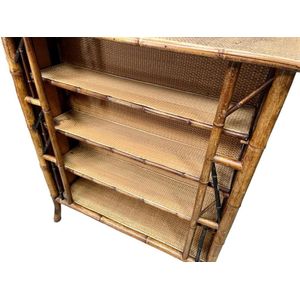Japonaise Bamboo and Cane Bookshelf, English 1900
A Japonaise bamboo and cane bookshelf, English circa 1900, height 115 cm, width 103 cm, depth 34 cm
You must be a subscriber, and be logged in to view price and dealer details.
Subscribe Now to view actual auction price for this item
When you subscribe, you have the option of setting the currency in which to display prices to $Au, $US, $NZ or Stg.
This item has been sold, and the description, image and price are for reference purposes only.
- Cane in Furniture Making - Cane, as used to make furniture is harvested from the ratan palm. The rattan palm is a type of climbing palm that is native to tropical regions of Asia and Africa. The stem of the rattan palm, also known as cane, is harvested, stripped of its skin, and then used to make a variety of furniture items. Rattan furniture is known for its durability, lightness and natural beauty. The cane is flexible yet strong and can be woven into various patterns, making it suitable for a wide range of furniture styles from traditional to modern. The furniture made from rattan cane is also known for its durability and resistance to extreme weather conditions. Popular items include chairs, tables, sofas, and cabinets. The natural colour of the cane can be preserved or it can be stained or painted for different looks.
- Circa - A Latin term meaning 'about', often used in the antique trade to give an approximate date for the piece, usually considered to be five years on either side of the circa year. Thus, circa 1900 means the piece was made about 1900, probably between 1895 and 1905. The expression is sometimes abbreviated to c.1900.
- Japonaise - In 1853, Japan ended the long period of self-imposed isolation from the rest of the world and trade with Europe and America gradually developed. Impetus was given by the Meiji Revolution of 1867-8 which began the ruthless Westernization of Japan. As the Japanese enthusiastically embraced all things western, there was a corresponding appreciation of traditional Japanese art forms in the west. This led to traditional Japanese designs being incorporated into furniture, ceramics, and silverware in the third quarter of the 19th century.
Examples of the Japanese influence are Japanese motifs, faux bamboo, fretwork and lacquer work.
This item has been included into following indexes:
